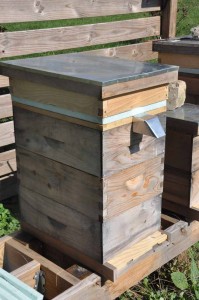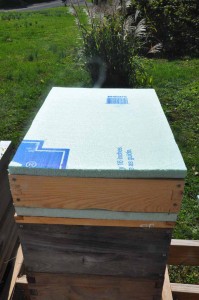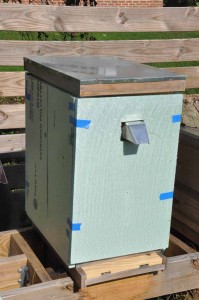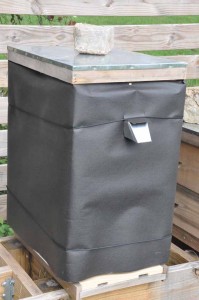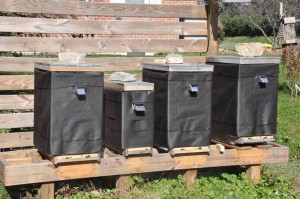In the early part of the spring, as I was both waiting for new bees and frustrated by the loss of last year’s bees, I wrote a long-winded post regarding the cold and insulation. Last year I did literally nothing to insulate my hives. This year, I’ve followed through on my plans. Each hive now has insulation over the inner cover, upon which is an “attic box” to help collect moisture. There is also insulation on top of that box over which is the outer cover. The entire hive then has a shell of R5 foam board insulation which is wrapped in 15# roof felt.
Also on the hives is a small, well, I’d guess you’d call it a gadget. Living in a home that leaks heat like a sieve, I couldn’t come to terms with putting a big hole in the top of the hive even though I know that the notch in the inner cover needs to be there to vent the moisture. I had to protect that in some small way. I fashioned some small “rooves” out of cheap aluminum sheet. These should help to keep the snow and rain out of that notch and may even help prevent the wind from sucking the air out of the hive while still allowing the moisture to vent.
The mouse guards I’m using are home made. This is a variation on a description by Michael Bush of the guards used in Nebraska where a few pieces of lath are nailed together forming a long tunnel-like entrance. The entrance is still 3/8″ high, but mice seem to avoid chewing through the long 3 1/2″ depth of this entrance.
As stated above the attic box will help collect extra moisture and keep it away from the cluster, but it serves another purpose. As spring rolls around and the need to feed arrives, the box is already in place to allow me to do so.
This all requires some pictures.
Here is the hive with its insulation above and below the attic box. The insulation above is not visible with the cover on. Notice the mouse guard and the notch “roof” also in place.
A view inside the attic box. #8 hardware cloth is over the hole in the inner cover keeping the bees out of the box but allowing the air to pass. This screen will be removed when feeding commences in the spring. The foil tape around the cutout is to prevent the bees from chewing up the edges of the foam when feeding.
A view with the insulation board on top of the attic box.
The hive completely surrounded with 4 pieces of insulation. The blue tape is simply painters tape used to hold the insulation in place while the rest of the wrap is installed.
The hive completely wrapped with the wrap and insulation secured with good UV resistance cord and a rock weighing down the cover. My covers are heavy and I normally don’t weight them, but I won’t be opening them all winter so the weight is not inconvenient and is just extra insurance against winter wind.
And finally the whole stand of wrapped hives. I certainly hope this makes for hives in which a slightly warm day will allow the cluster inside to readjust and move to stores should they need to do so.
I’ve given much thought to losing both hives last year, and to the reasons. I think the main reason was not treating, as late in the season I clearly remember seeing deformed wing. By the time you see that, you’ve got a mighty mite load. But I also reflected on the advice I received last year, mostly online since that’s how most of us connect these days, but the advice probably would have been the same if received locally and face-to-face.
The advice was given by those with many hives, and by many I don’t mean 50 or 100, but 10-20. When asked if this action or that action should be taken, the result was by and large the same, “It doesn’t make a difference.” Insulating, closing off bottom boards, etc.
The point of this is that those with 7 hives, 10 hives, 20 hives, giving advice to new beekeepers with 1-2 hives is a tricky business. First, because the new beekeepers is just that, new, which means the hives, too, are new. Second because decisions about performing labor for the bees are made based on return, and it’s a matter of odds.
Let’s say the chance of a first year untreated hive dying over the winter is 40%. This sounds high, but first year + untreated means a tough first winter. The experienced 10 hive beekeeper probably doesn’t have many first year hives, so his odds of loss are automatically lower. But even if they were the same, he’s making his labor decisions based on what he thinks will happen and what he can do next spring. With 10 hives, he’ll have more than a few surviving hives, probably make splits to cover the losses, and maybe even get some honey if the flows are good. I know I’m simplifying the math and the world doesn’t necessarily work this way, but if we look at each hive as its own independent trial, we can work this like a binomial distribution. With 10 hives, his odds of being completely wiped out are 1/100th of 1%…that’s losing all 10 hives when each hive has a 40% chance of dying. To lose even 7 or more hives, his chances are only about 5 1/2%. This means he has over a 94% chance of coming through winter with at least 3 hives. A terrible loss to be sure, but he still has bees. Remember, his labor decisions are made with this in mind. Spending hard earned cash along with the time required on medication, treatment, insulation, etc, is weighed against these odds. And as we’ll see these probably are not the new beekeepers odds.
New beekeepers generally start with one hive, maybe two. Now lets look at that first year beekeeper with two hives and the same chance of failure at 40%. His chance of losing both his hives and being completely wiped out is 16% 16% chance of having no bees vs 0.0001% chance for the 10-hive beekeeper. This new beekeeper’s chance of losing at least one hive is a whopping 64%
As you can see, it’s a numbers game, and with respect to the grain of salt needed when small, first year beekeepers take advice from experienced beekeepers with many more hives…well, that grain of salt should probably be a lot bigger. My advice to a new beekeeper with one or two hives? If you’re thinking about doing something to help your bees through the winter and you ask experienced beekeepers with many hives and they reply, “You can, but I don’t.”, then do it.
Every time I look at the Russell Apiaries web site I want to buy a queen. I mean every single time. His off-the-beaten-path offerings (like the MMAs) just look so neat. I have to completely control myself to not start adding queens to a shopping cart. It’s just in my nature to want to experiment and tinker, and doing so with the hives just seems natural. This year though I need to remind myself that even though I’m feeding at the end of this season, four of my seven queens are locally mated. All of those (except the swarm queen) are only first generation, so the parents of those queens are southern bees, but the bees they are now producing hopefully have some good survivor genetics.
Maybe next year I’ll buy a queen or two in order to start a new hive or a nuc, but whenever I want to buy a queen in order to requeen what I’ve got just for the sake of having a neat new queen, I have to keep reminding myself that all my colonies are queenright with seemingly good layers, many of them mated here, and there’s no good reason for me to be screwing around with that.
The remnants of Lee gave this area our third largest flood in history and kept the bees in eating their stores for a good four days. But alas the rains lifted and finally left, and I was able to get all of my rearranging done. Dummy boards are in where needed and I’m now on a feeding regimen and hoping to get the hives quite weighty before the cold comes. There should be quite a number of weeks of foraging left. I don’t plan on really entering the hives much more this season if at all. They queens are laying, the comb equalized, and I’m happy with the layout. All that’s needed from an internal perspective is to fatten them up so to speak as most all were on the light side, but after starting with nothing but packages and then stealing from the rich to give to the poor, that’s not surprising. I’m now truly focused on survivability for the winter.
As a revisit from a previous post, the nuc combine seemed to go off without a hitch. The newspaper was well chewed and the bees nicely mingled when I opened them to add there final dose of comb. I was a little concerned since I found another queen cell at the bottom of one of the Alahambra frames. I cut it out and went through the bottom and found the queen. I put her back as gently but as quickly as I could and closed them back up.
I was searching for a proper explative to use in the title of this post, but none seemed both fitting and becoming (all were four letters long). The remnants of tropical storm Lee are dumping inches of rain over the next four days. I really need to rearrange frames in order to get feeders on the hives and losing a whole week to this rain isn’t helping. I also need to make dummy boards, which may require that I bring my saw horses up on the porch in order to get them done.

